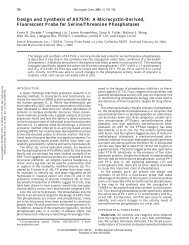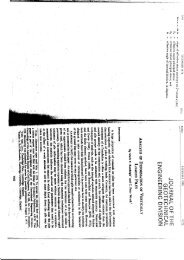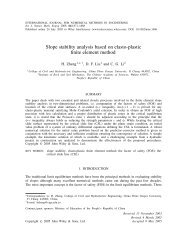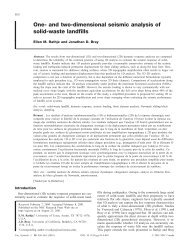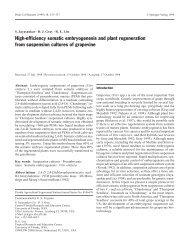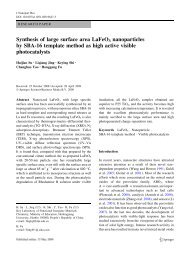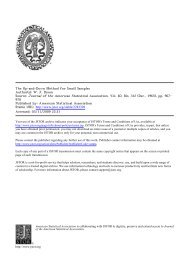PROPAGATION OF ELASTIC WAVES IN LAYERED MEDIA BY ...
PROPAGATION OF ELASTIC WAVES IN LAYERED MEDIA BY ...
PROPAGATION OF ELASTIC WAVES IN LAYERED MEDIA BY ...
You also want an ePaper? Increase the reach of your titles
YUMPU automatically turns print PDFs into web optimized ePapers that Google loves.
392 BULLET<strong>IN</strong> <strong>OF</strong> THE SEISMOLOGICAL SOCIETY <strong>OF</strong> AMERICA2.0, 3.0 and 5.0. When p2/pl = 0, which is the special case of a free surface, we againfind the Rayleigh wave. As p2 increases, the interface wave continues and arrives attimes expected for either the Stoneley wave or the "second surface wave."* Sincethe phase velocity of Stoneley waves is very nearly v,1, and that for the "secondsurface wave" is exactly v~, the pulses overlap and are not resolved. As p~/pl increasesup to 1.0, the amplitudes of the horizontal and vertical components of theinterface waves decrease. At p2/o~ = 1, the amplitudes are zero and no interfacewave is found. Recall that these are still different media with different velocities.The horizontal component decreases more rapidly than the vertical component as16.0A×R 212.0AxR z8.0& :0,o 2: .2p~AxR 2P2 = .4p,AxR 24.0gI22= ,.oe,-4.Cz.'ot"vs,/d_B×R 2t~ -BXR24:0 ~ ~---B×R 2--7 I8.0FIG. 17. Horizontal and vertical displacements on the interface separating two semi-infiniteelastic media. A compressional point source of pulse width .8 is located in the upper medium(vc~ = ~/1.05vct , v~2 = %/~v,1). The observation point is located on the interface at a distanceof four times the height of the source above the interface measured from a point directly belowthe source. The four curves are for density contrasts o2/ol given by 0, .2, .4 and 1.0.the density contrast increases from 0 to 1. For the Rayleigh wave the ratio of thehorizontal to the vertical component is approximately .68, while for the interfacewave the ratio is smaller. For p~/pl larger than 1 and increasing, the amplitude of theinterface wave increases again and it appears mainly in the vertical component.Notice that there is a phase change of 180 ° in this component in passing through thevalue P2/pl = 1.The phase velocity of Stoneley waves is a root of an equation originally derived byhim (1924). The region in which these roots exist is given in the book by Ewing,Jardetzky and Press ( see p. 113) and also in the book by Cagniard. ( See Figures 4-6,p. 49. In this figure the vertical scale is incorrect and should be changed to* A name used by Cagniard (1962) for the surface wave that travels along the interface withthe shear velocity v,t •



